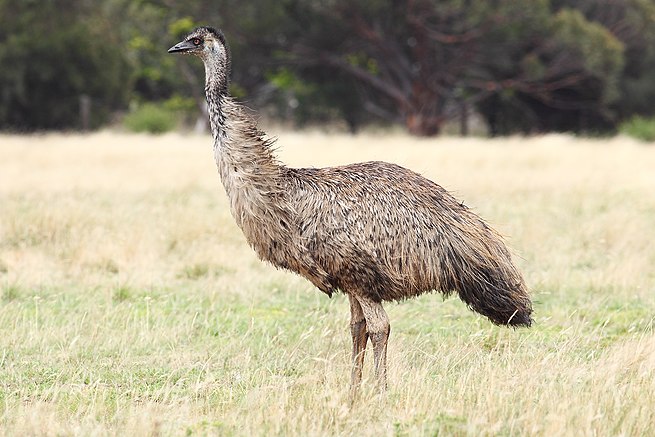
Main Difference
The main difference between Emu and Kiwi is that the Emu is a largest bird native to Australia and Kiwi is a genus of birds.
-
Emu
The emu (Dromaius novaehollandiae) is the second-largest living bird by height, after its ratite relative, the ostrich. It is endemic to Australia where it is the largest native bird and the only extant member of the genus Dromaius. The emu’s range covers most of mainland Australia, but the Tasmanian emu and King Island emu subspecies became extinct after the European settlement of Australia in 1788. The bird is sufficiently common for it to be rated as a least-concern species by the International Union for Conservation of Nature.
Emus are soft-feathered, brown, flightless birds with long necks and legs, and can reach up to 1.9 metres (6.2 ft) in height. Emus can travel great distances, and when necessary can sprint at 50 km/h (31 mph); they forage for a variety of plants and insects, but have been known to go for weeks without eating. They drink infrequently, but take in copious amounts of water when the opportunity arises.
Breeding takes place in May and June, and fighting among females for a mate is common. Females can mate several times and lay several clutches of eggs in one season. The male does the incubation; during this process he hardly eats or drinks and loses a significant amount of weight. The eggs hatch after around eight weeks, and the young are nurtured by their fathers. They reach full size after around six months, but can remain as a family unit until the next breeding season. The emu is an important cultural icon of Australia, appearing on the coat of arms and various coins. The bird features prominently in Indigenous Australian mythology.
-
Kiwi
Kiwi ( KEE-wee) or kiwis are flightless birds native to New Zealand, in the genus Apteryx and family Apterygidae. Approximately the size of a domestic chicken, kiwi are by far the smallest living ratites (which also consist of ostriches, emus, rheas, and cassowaries).
DNA sequence comparisons have yielded the surprising conclusion that kiwi are much more closely related to the extinct Malagasy elephant birds than to the moa with which they shared New Zealand. There are five recognised species, four of which are currently listed as vulnerable, and one of which is near-threatened. All species have been negatively affected by historic deforestation but currently the remaining large areas of their forest habitat are well protected in reserves and national parks. At present, the greatest threat to their survival is predation by invasive mammalian predators.
The kiwi’s egg is one of the largest in proportion to body size (up to 20% of the female’s weight) of any species of bird in the world. Other unique adaptations of kiwi, such as their hairlike feathers, short and stout legs, and using their nostrils at the end of their long beak to detect prey before they ever see it, have helped the bird to become internationally well-known.
The kiwi is recognised as an icon of New Zealand, and the association is so strong that the term Kiwi is used internationally as the colloquial demonym for New Zealanders.
-
Emu (noun)
A cassowary (genus Casuarius). from early 17th c.
-
Emu (noun)
A large flightless bird native to Australia, Dromaius novaehollandiae. from 18th c.
-
Emu (noun)
initialism of electromagnetic unit
“EMU”
-
Emu (noun)
clipping of emulator
-
Kiwi (noun)
A flightless bird of the genus Apteryx native to New Zealand.
-
Kiwi (noun)
alternative case form of Kiwiperson from New Zealand.
-
Kiwi (noun)
A New Zealand dollar.
-
Kiwi (noun)
A kiwi fruit.
-
Kiwi (noun)
A green-yellow colour, like that of kiwi flesh.
“color panel|95B43F”
-
Kiwi (noun)
A member of the air force who does not fly.
